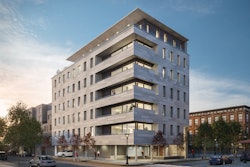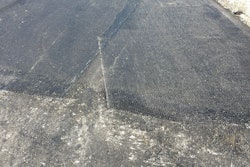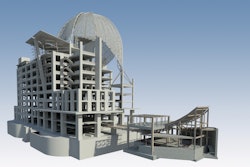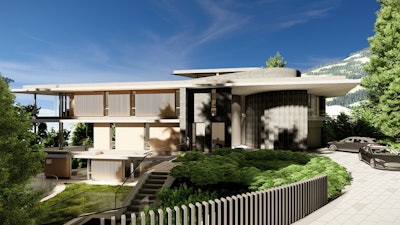
Click on the image above or photos below to open an online photo gallery and view additional images..
Perched on the hillside of Whistler Mountain—one of North America’s top ski resorts—the 20,000 sq. ft. (1,800 sq. m) Kadenwood residence complies with stringent energy efficiency and seismic requirements. Its footprint is a four-sided polygon with sweeping views of coastal mountains and alpine lakes. The four-story ski-in/ski-out structure features an elevator that transports occupants from the entry-level to the ski slopes 50 ft. (15 m) below. The top three stories have year-round accommodations for the homeowners and separate suites for three other families.
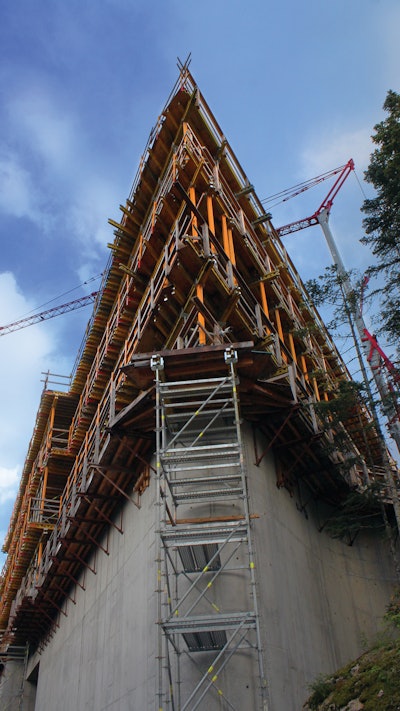 A triangular ship’s bow profile with floor-to-ceiling glazing projects toward the mountains. Concrete-to-concrete structural thermal breaks insulate and support the cantilevered roof and floor plates. Interspersed are thermal break modules for earthquake load transfer.Schöck North America
A triangular ship’s bow profile with floor-to-ceiling glazing projects toward the mountains. Concrete-to-concrete structural thermal breaks insulate and support the cantilevered roof and floor plates. Interspersed are thermal break modules for earthquake load transfer.Schöck North America
When Kadenwood construction began, he says that building codes in Canada encouraged the use of structural thermal breaks to mitigate thermal bridging, and with the current BC Energy Step Code, the building would have to include them to meet the high energy performance target.
Transferring Loads but Not Heat
Cantilevers impart high rotational and shear forces, especially in the mountains of Western Canada due to the district’s snow loads of 8.5 kPa (176 psf), compared to design loads of 1.64 kPa (34.3 psf) in low-lying Vancouver, which is 125 mi (200 km) to the south. The designers needed cantilevered structures that could not only carry those loads but also meet the seismic requirements of the region.
“The whole structure is concrete—from the basement to the roof,” says concrete contractor Graham Roberge of Alpen Construction, a subcontractor of Bradner Homes Ltd. “We used about 2,616 cubic yards (2,000 cubic meters) of concrete and a million pounds of (reinforcing) steel on the project.”
Given the high thermal conductivity of concrete and steel and its high surface area exposed to Whistler’s frigid winter temperatures, the design team needed to mitigate thermal bridging and its unwanted effects.
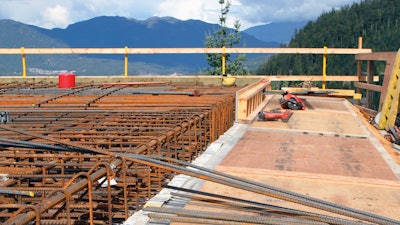 The wide roof overhang on the right is cantilevered while maintaining thermal and structural integrity using Isokorb® concrete-to-concrete structural thermal breaks. The concrete for the balcony is in place while the much thicker interior slab is being formed up.Schöck North America
The wide roof overhang on the right is cantilevered while maintaining thermal and structural integrity using Isokorb® concrete-to-concrete structural thermal breaks. The concrete for the balcony is in place while the much thicker interior slab is being formed up.Schöck North America
Four Types of Structural Thermal Breaks Insulate & Support Cantilevers
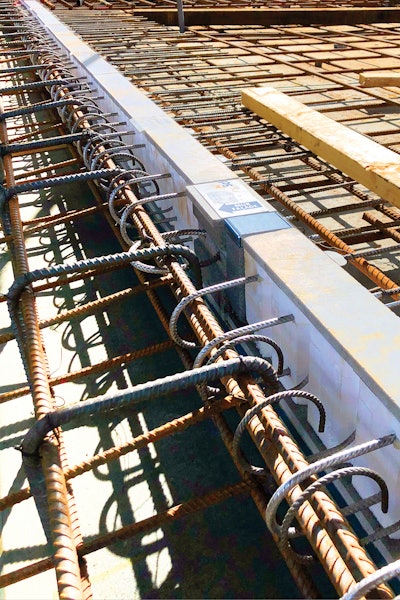 Structural thermal breaks for slab edges insulate and support shorter cantilevers such as “eyebrows” over windows.Schöck North America
Structural thermal breaks for slab edges insulate and support shorter cantilevers such as “eyebrows” over windows.Schöck North America
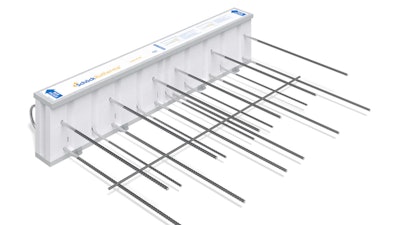 Schöck North America offers load-bearing thermal insulation elements for exposed concrete slab edges that transfer minor moment and shear forces from the dead load of the façade material and slab edge to the main concrete slab.Schöck North America
Schöck North America offers load-bearing thermal insulation elements for exposed concrete slab edges that transfer minor moment and shear forces from the dead load of the façade material and slab edge to the main concrete slab.Schöck North America
Above several windows, the architects incorporated concrete “brows” that overhang a short distance similar to a sunshade. For these small cantilevers, the design team specified Isokorb® concrete-to-concrete thermal breaks for slab edges. The stainless steel rebar penetrating the insulation block ties into the interior slab rebar. On the exterior side, the rebar forms into a loop to support the small cantilever.
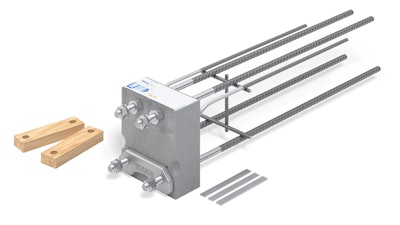 Isokorb® thermal insulation elements isolate steel cantilever attachments, such as balcony supports, canopies and sunscreens, that connect to concrete slabs. The element transfers bending moments and shear forces.Schöck North America
Isokorb® thermal insulation elements isolate steel cantilever attachments, such as balcony supports, canopies and sunscreens, that connect to concrete slabs. The element transfers bending moments and shear forces.Schöck North America
The fourth Isokorb® thermal break used connects concrete to steel at the steel balcony that cantilevers from the concrete structure over the entry area. The stainless steel rebar on the interior side of the module is wired into the floor slab rebar. Once cast in concrete, the exterior threaded side of each rod is bolted to steel balcony beams using backing plates and high-strength stainless steel nuts.
Roberge estimates his crew installed about 1,000 linear feet (300 meters) of concrete-to-concrete thermal breaks and 30 concrete-to-steel thermal breaks.
Preventing Condensation & Mold
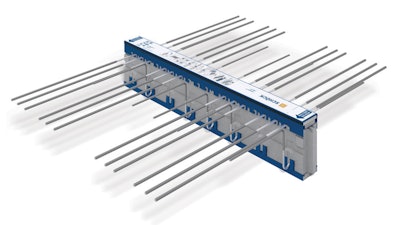 This type of Schöck Isokorb® concrete-to-concrete structural thermal break transfers bending moments and shear forces, while preventing heat energy waste, chilled interior floors, and formation of condensation and mold.Schöck North America
This type of Schöck Isokorb® concrete-to-concrete structural thermal break transfers bending moments and shear forces, while preventing heat energy waste, chilled interior floors, and formation of condensation and mold.Schöck North America
While the alpine climate on Whistler Mountain averages a nippy 7-19°F in mid-winter, temperatures also fluctuate dramatically year-round due to the region’s proximity to the temperate coastal region, exacerbating problems of condensation and mold. “Whistler isn’t like Alberta where everything freezes until spring. There is a constant freeze/thaw cycle,” Pettit says. “Humidity in the house can start to condense on the cold surfaces and cause problems.”
Openspace began specifying structural thermal breaks in 2014 when designing another Whistler Mountain project. “On that building, we were trying to figure out how to hang heavy concrete cantilevers by designing our own bolt-on details. When we happened upon the Isokorb® products, I was excited,” Pettit says. “They were the perfect solution to the problem.”
About the author
Tracy Dacko has more than 25 years in building products strategic marketing management. She is the former president of the New Jersey chapter of the Business Marketing Association, served on the Board of Trustees for PeopleCare Center for Human Services, and has authored numerous articles and published works.
Originally published in Modern Contractor Solutions, January 2021.




